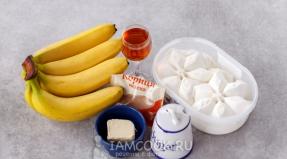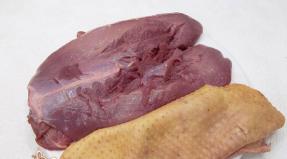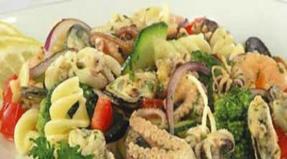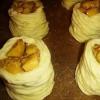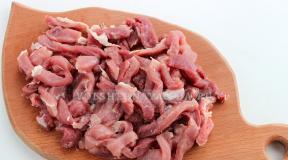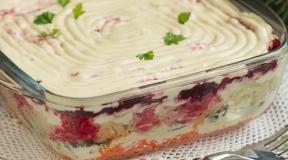What to prepare for the winter in the freezer. Homemade chocolate or regular cookies
With the advent of household freezers, the ways of preserving stocks for the winter have changed. If earlier the hostess dried dill and parsley all summer, now she freezes not only them, but berries, root crops and other greens. It is believed that with proper freezing of products, vitamins, the taste and aroma of summer abundance are preserved in them. It is important to carefully prepare the ingredients, ensure non-destructive preservation and storage conditions.
From the summer harvest there are few plants that under no circumstances should be frozen. These include:
- Onions and garlic - lose their beneficial properties and taste. Even in semi-finished meat products with a large amount of these seasonings, the taste changes for the worse.
- Raw potatoes - lose their shape, the taste becomes nasty-sweet, poison appears - corned beef. Puree does not lose its taste.
- Apples lose their taste, shape and darken. The melon turns into a shapeless mass and is bitter.
- Radish, radish, lettuce become unusable.
Of dairy products, after freezing, sour cream changes its consistency and taste, butter crumbles without spreading on a sandwich, milk becomes heterogeneous.
All other products can be frozen, but each type has its own technology on how to properly prepare products. So, spicy greens in the freezer should be spread out on a pallet in portions at one time, frozen in a thin layer, at maximum temperature, and then collected in an airtight container. As soon as the leaves melt in the air, they will darken. Therefore, the cube is immediately used in a dish or pre-melted in ice water.
Some berries are placed in a prepared container in the form of mashed potatoes, lightly sprinkled with sugar. Other wild plants - cranberries, lingonberries, blueberries after defrosting retain their shape and taste. But blueberries and strawberries need to be sprinkled with a little sugar on top. Green peas need to be blanched and cooled, and wild mushrooms should be cleaned, boiled in slightly acidic salted water and spread out in small portions. The requirement for all products remains unchanged - their quick freezing and storage at sub-zero temperatures.
All meat and fish products, except for caviar, can be frozen and stored for a long time in the freezer. Refrigerators are used for products that are eaten within a few days. Some of them can not be frozen, others are consumed chilled, with more health benefits.
Shelf life of food in the freezer
No product is stored in a state of deep freezing forever. Biological decomposition processes continue if there is no absolute zero (- 273 0 C). In a home freezer, on average, all supplies are stored at -18 0, even a little less. Studies show long shelf life reduces the benefits of the product in proportion to time. This is especially true for fatty fish.
To avoid misuse of packaged supplies, labels with the name and date when the container was loaded can be used. Subject to the rules of storage in the freezer, you can take into account the terms recommended by experts.
Table of shelf life of products in the freezer at a temperature of - (14-20) 0 C
| Product | Shelf life | Product | Shelf life | |
| Meat | 4-6 months | Vegetables | 4 months | |
| Meat semi-finished products | 3-4 months | Spices | 6-8 months | |
| Bird | 9 months | Roots | 1 year | |
| Bird giblets | 3 months | melons | 9 months | |
| Oily fish | 2-3 months | Mushrooms | 8-12 months | |
| small fish | 6 months | Berries | 6 months | |
| Fish p/f | 3-4 months | Mixes | 1 month |
You can freeze both the broth and mashed potatoes, but after that you should use the entire workpiece at once, preventing air from entering the package. Only your own blanks, the safety of which you are sure, will be useful. Therefore, it is better to boil forest mushrooms so as not to leave chances for botulism to get divorced in the package. Berries and greens from the garden should be washed and dried.
How to freeze food in the freezer
What is the reason for the change in the taste of food after freezing? Cellular sap from protein and plant foods mainly contains water. When frozen, ice crystals damage cell walls and change structure. That is why the taste of frozen foods is different. When the freezing is slow, the crystals grow, become large, and destroy the shells more strongly.
But if the product is frozen quickly and at a low temperature, there will be many crystallization centers, small crystals, and little damage to the cells. The nutritional value of the product will be preserved. That is why you need to freeze in small portions, and then pour the product into an airtight container, setting it in the freezer.
For freezing poultry carcasses, large pieces of meat, it is important that an ice crust form on top as quickly as possible. That is why winter ice fishing provides the freshest fish - it freezes immediately.
The freezing time of prepared foods in the freezer is individual for each type of preparation. During the conservation period, freezing goes through 3 processes - cooling, freezing and freezing. The faster each stage passes, the better quality the semi-finished product will acquire at the final stage. At a temperature of -(18-24) 0 C, the process takes 2.5 hours. The product becomes loose. Temperatures above 35 degrees are energy-consuming, and do not add quality to freezing.
Preparation for use is the reverse process - thawing should take a long time. At this time, the crystals should again turn into cell sap.
How to arrange food in the freezer
There are different types of freezers. Those equipped with the No Frost system have the same temperature in any corner of the cabinet. If manual defrost is used, the lowest temperature is near the evaporator, more often in the top drawer. Consider how to arrange products, taking into account the requirements for their storage in the freezer.
So, puree from fresh berries, frozen in cubes, can be stored at minus 8-12 0 . The lowest temperature sector should be assigned to oily sea fish and seafood. Meat will be preserved for 3-4 months without a change in taste at a temperature below -12 0 C. Do not allow food to thaw, this will lead to hopeless damage to stocks.
It is important to choose the right container for packaging. Ordinary polyethylene becomes brittle under deep-freeze conditions, the bags fall apart. It is necessary to use a dense food polymer or special containers with airtight lids. The drawers of the freezer are filled with products by 2/3, leaving ventilation passages between the packages. The cells at the bottom of each box are not covered, they are needed to ventilate the chamber.
Having fulfilled the above requirements, you will cook borscht with the aroma of summer vegetables in winter. Jam from a fresh serving of berries with a minimum of sugar is immeasurably tastier than prepared for storage in a warm room.
Video
We offer you to watch a useful video on the topic.
How to store food in the freezer
1. To homemade layered cake looked like it came from a candy store, freeze it for a bit. Then you can easily cut off the top layer to cover the cake with cream or icing. Get it very neat.
To make it easier to cut the top layer of the cake evenly, freeze it briefly.
2. Many have not even thought about freezing bread. We suggest trying to make toast from frozen slices, the taste is completely different! Just remember that before you put the bread in the freezer, you need to cut it, separate the slices with baking paper, wrap everything in foil, and only then freeze it. Otherwise, you will ask yourself more than once why there is no saw in the kitchen besides a knife.
3.Greenery fades quickly, but there is a way to always have fresh herbs on hand. And not only parsley or dill, but also spinach or arugula. Wash the greens, dry, cut, arrange in different freezer bags and send to the freezer. Use as a base for salads, an addition to rice, noodles, pasta dishes.
4. Frozen meat it is much easier to cut into thin translucent slices, and for this you do not even need to be a skilled chef. 15 minutes will be enough for bacon, fresh meat will need a little more.
 Olive oil can be frozen along with various herbs and added to salads, hot dishes, or when frying.
Olive oil can be frozen along with various herbs and added to salads, hot dishes, or when frying.
5. In case the broth needs vegetables, keep a separate bag of frozen scraps. Parts of celery, carrots, and even mushroom stalks that are unnecessary for dishes are quite suitable.
6. If the broth in freezer bags is no longer a rarity, then fat, leftover after frying bacon, frozen in ice cube trays - something new. Store these frozen cubes in a separate bag. This method is also suitable for olive oil. Heat it with herbs, let it boil and remove from heat. Pour into molds, freeze and take out a couple of minutes before you need to fry or season anything.
 The zest without the bitter white part is easier to get if you first send the lemon or lime to the freezer.
The zest without the bitter white part is easier to get if you first send the lemon or lime to the freezer.
7. The freezer trick is great for the whole citrus fruits- orange, lime, lemon. They are frozen, then to get the perfect fragrant zest, without the bitter white part.
8. When you are preparing a salad, quinoa and other grains sometimes you need to quickly cool, and the freezer is an indispensable assistant here. 5-10 minutes, and the temperature will drop to room temperature. The same approach works for nuts, which are slightly overexposed in the oven. Freeze them to prevent them from burning completely.
9. Homemade jam and jam can be stored in the freezer for up to a year. Boil fresh fruits in water with pectin, sugar, spices and spices for several minutes, cool, and then pour into jars. Be sure to leave some free space in the jar because the liquid will expand when frozen.
 The most healthy and delicious ice cream is easily made from frozen bananas and berries.
The most healthy and delicious ice cream is easily made from frozen bananas and berries.
10. If you do not want to experiment with freezing different foods, then just try banana ice cream. This is an incredibly healthy and tasty alternative to the usual creamy dessert. Frozen bananas are sent to a mixer with berries, nut butter or simply without additives until a gentle cold cream is obtained.
And which ones are by no means worth it - not an easy task for novice cooks and culinary specialists. After all, it can be easy to get frustrated after spending a lot of time and money on a large batch of freezer food, and then find a disappointing result.
The problem is that some products just not meant to be frozen and this kind of trouble with them is inevitable.
Once you figure out what is freezerable and what is not, you will save a huge amount of money and time spent in the kitchen, and at the same time you will be able to cook healthy food at home.
Products suitable for freezing.
Freezing meat, poultry and fish you are guaranteed success. Raw meat is preferable for long-term storage, because. it does not dry out or "freeze burn" as quickly as pre-cooked meat.
Bread and bakery products You can freeze them too and they do great in the freezer. For example: cakes, pies, muffins, bagels, yeast and yeast-free dough of any consistency (liquid, thick, kneaded) or already baked, raw or ready-made cookies, pizza - both ready-made and semi-finished.
Butter and margarine great for freezing.
Also you can freeze beans, and at the same time save money by buying them in a dry form, and then, after soaking, cook it yourself, rather than buying all kinds of canned food.
Rice suitable for freezing, it can even be cooked in advance so as not to waste extra time in the future.
Products whose properties may change when frozen.
Most products fall into this category.
Any fruits and vegetables will become softer. And fruits and vegetables with a high water content may be difficult to freeze. Some fruits and vegetables are strongly recommended to be cooked only after they have completely thawed, although there are some that can be eaten chilled, slightly thawed. In addition, they need to be prepared for freezing.
Potato excellent for freezing, it can easily be used to prepare various side dishes, but, nevertheless, it must be frozen boiled to eliminate the possibility of blackening.
Pasta will also become much softer, so after freezing they should be cooked a third less than the recommended time. Pasta frozen in liquid or sauce will absorb much of it.
Milk and dairy products can be frozen, but there is a chance that they will curl up. The cheese will become crumbly, making it difficult to cut, but it will remain usable for cooking and melting.
Greenery will lose its texture but retain its flavor. Can be used as a condiment, but not as a garnish.
raw eggs can be frozen, but you must first remove them from the shell and add salt or sugar to avoid spoiling the product
Omelette or eggs fried according to a different recipe can be frozen. Boiled eggs are not worth it, because. the protein will harden and acquire a "rubber" aftertaste.
Salty fatty foods such as bacon, sausages, ham, hot dogs and other similar meat and fish snacks should not be stored in the freezer for a long time. The recommended period is 1-2 months. With prolonged freezing under the influence of salt, the fat becomes unpleasant in taste, rancid. But many people keep these products longer, so use your own judgment, however, if the product looks or smells spoiled, it should be thrown away.
Foods that cannot be frozen.
Gelatin loses its properties or evaporates the liquid.
Vegetables such as lettuce, cabbage, celery, radishes or cucumbers will turn into a watery porridge. However, frozen celery can be used to make stock.
melons become very soft and lose most of the juice, they can of course be used for cocktails and smoothies (refreshing fruit drink), but in general it is not recommended to freeze.
The merengue fillings will become hard and rubbery.
Custard and cream puddings may curl up.
Mayonnaise also tends to roll over.
Products, deep fried stop crunching.
Loose bakery decorations for desserts and casseroles will get soggy.
Icing and other decorations for desserts based on egg white will lose their properties.
The freezer can be filled not only with meat, fish and berries. There are many foods that can be frozen without loss of taste. Frozen food will quietly wait for its turn, and you do not have to throw it away or quickly eat it up so as not to spoil. Here are 20 foods you can freeze and how to do it.
1. Cheese
You can freeze a large piece of cheese, and once thawed, it won't crumble. If you prefer to slice the cheese before freezing, add a teaspoon of cornstarch or flour to the container to keep the slices from sticking together during defrosting.
If you like to add grated cheese to your dishes, you can buy a large piece of Parmesan, chop it in a food processor and put it in the freezer in freezer bags. It can be stored in the freezer for several months, and during preparation it will be enough to open a container or freezer bag and get a couple of teaspoons of cheese.
2. Homemade pancakes, waffles and French toast
If you'd like to eat more homemade pancakes, waffles, and toast for breakfast, you can simply bake more on your day off, freeze on a cookie tray, and store in freezer bags.
At any time you can get them out of the freezer, reheat in the microwave and have breakfast. In any case, it will turn out cheaper and tastier than buying frozen pastries in the store.
3. Fruit
Fruits are best frozen on parchment paper, and only then placed in freezer bags. It’s best to freeze the cut pieces right away so you can get them for desserts and smoothies as needed.
If you are a smoothie lover, you can make yourself a frozen fruit mix right away. Separately freeze pieces of apples, pears, peaches, bananas and other fruits you like. At any time, you can make yourself a new smoothie by mixing different types of fruits.
If you don't like making slimy thawed banana pieces, freeze them whole, with the skins on. When you decide to cook something with a banana, you need to take it out of the freezer, defrost it in the microwave, cut off the top and squeeze the contents into the cooking mixture.
4. Rice
Instead of waiting too long for rice (especially brown rice, which takes about 50 minutes to cook), you can freeze it. First, the rice is frozen on a tray or parchment, and then placed in a freezer bag.
Thawed rice can be fried, used for soup or casseroles. Cooking time will be reduced by about an hour (including not only boiling, but also rinsing and soaking).
5. Pies
You can make more apple pie and enjoy it for several months. Wrap it in freezer paper, place it in a plastic bag and put it in the freezer. When you want to taste the pie, send it to a preheated oven (about 150 degrees) for 2 hours.
6. Corn
The easiest way to freeze corn is not to get it out of the leaves, but just put it in the freezer. When you want corn, just take it out and heat it up in the microwave for 5 minutes. The leaves protect the corn kernels so it tastes fresh.
7. Tomato paste
Simmer the Roma tomatoes over low heat with garlic, fresh herbs and olive oil for about 4-5 hours. Once the mixture has cooled, place it in freezer bags. You can use this mixture for chili base or tomato sauces.
8. Pasta
Boil more pasta and freeze small portions in different bags - you can use one small bag for soups and casseroles.
Before freezing, make sure to release the air from the bag - it should be as flat as possible. To defrost, soak the sealed bag in hot water for a few minutes.
9. Mashed potatoes
Use an ice cream scoop to scoop out a scoop of mashed potatoes and place a scoop on parchment paper.
Freeze until balls are firm and then store in freezer bags. Puree will keep in the freezer for at least two months.
10. Cookie Dough
The cookie dough is frozen on parchment and stored in a freezer bag. You can divide it into separate portions or immediately make it in the desired form.
Using this dough, you can cook cookies in 1-2 minutes, without dirty dishes and tables.
11. Potato chips
If you buy enough chips and freeze them in the same package they came in, you'll always have a snack.
Plus, frozen chips are even tastier than regular chips, so you don't need to defrost them before eating them.
12. Milk
If your milk is consumed very slowly, and the remains turn sour and pour out, it is quite possible to freeze it until the next time.
Just pick a bottle that leaves room as frozen liquids expand. Thawed milk should be mixed well and can be used (just do not defrost it in the microwave).
13. Juice
The only criteria for freezing juice, just like freezing milk, is a bottle large enough to allow the frozen drink to expand.
14. Bread
In order not to have to throw out dry bread, you can cut several loaves and freeze. As needed, take out the desired pieces of bread and defrost them in the oven or microwave. To prevent the bread from drying out until morning, you can leave it overnight in the switched off, tightly closed microwave.
15. Pieces of vegetables
You can freeze chopped onions, bell peppers, or chili peppers in freezer bags. When they're cold enough, you can mark "portion lines" on the bag so you know how much to take at a time.
16. Lemon and lime juice, lemon zest
Squeeze lemon and lime into ice cube trays and place in the freezer. Now you will have fresh citrus juice at any time. The zest can also be frozen and used in a variety of dishes.
17. Herbs
You can freeze aromatic herbs in ice cube trays with a little water or broth to use all year round in soups, stews, or casseroles.
18. Marinated meat
Put the meat in a freezer bag, pour over the marinade and send it to the freezer. When you take it out, it will be marinated and ready to be cooked right away.
19. Homemade casseroles
When you're making a casserole, like lasagna, why not make a bigger one and freeze half of it to enjoy some homemade food during the work week.
You can use several options for freezing:
- Freeze the whole casserole in a dish lined with freezer paper. When the casserole is cold enough, remove the platter, repackage the casserole in freezer paper, and put it back in the freezer. The good thing is that you can use the dish while the casserole is stored in the freezer. When you need it again, put it in the same dish and cook it.
- Freeze in batches. Prepare the casserole, let cool, cut into pieces and freeze. Can be heated in the microwave.
20. Fish sticks
Semi-finished products that are sold in stores can hardly be called tasty, so why not make homemade fish sticks?
To do this, you need to buy fresh fish, cut it into small pieces, roll in egg, flour or breadcrumbs, put on a tray and freeze.
After that, you can store homemade fish sticks in freezer bags - they are much tastier than store-bought ones, inside of which there is incomprehensible minced meat instead of fish.
Have you tried freezing any food?
For several years in a row, I prefer freezing for the winter in the form of vegetables, fruits, berries and other delicacies to seamings: the freezer helps to preserve the maximum amount of nutrients, and the technology of cooking at home saves the family budget. Let's talk about how to properly freeze food for the winter, and what can be put in the freezer to enjoy delicious bright food on cold evenings.
What can be frozen in the freezer
The list of blanks for the winter in the freezer can be endless. However, not all housewives are happy owners of a freezer, limiting themselves to four drawers in the refrigerator.
Before deciding what to freeze for the winter, decide:
- what is in high demand in your family (maybe you can't live without broccoli or mushrooms);
- what foods are available during the winter season (for example, I do not recommend freezing carrots or beets);
- how much you are willing to allocate space for vegetables and fruits.
For harvesting, buy seasonal products, the prices of which are lower than ready-made freezing. For example, frozen sea buckthorn and blackberries in our region are cheaper than fresh ones, which means that it makes no sense to freeze these berries yourself.
Freezing rules and technology
Main cooking requirements frozen vegetables, herbs and berries:


Freezing vegetables for the winter will be better if you plan them before going to the freezer. To do this, place a colander with pieces in boiling water for 30-60 seconds, and then dry.
Try to pack products in portions so as not to break the tightness of the package and not defrost an extra portion of the fruit.
Shelf life
By observing the freezing periods, you preserve your health.
You can store frozen fruits and vegetables for no more than a year at a temperature below - 18 C, up to - 8 C no more than three months.
Re-freezing is excluded: if you have thawed a bag of mushrooms, use the entire volume of the product.
What is frozen for the winter
Almost any fresh food can be stored in the freezer without loss of vitamins and taste.
Vegetables
You can freeze any vegetables for the winter. It is not recommended to store in the freezer only:
- cucumbers;
- swede, turnip;
- lettuce leaves;
- raw potatoes.

What vegetables can be frozen?
Tomatoes. It is better to take fleshy, non-watery fruits (for example, lady's fingers) or cherry. Small tomatoes are frozen whole, after removing the skin from them. You can make tomato puree (useful for making pasta, soups, sauces).
 frozen tomatoes
frozen tomatoes If you prefer to freeze sliced tomatoes, place them on a sieve to drain excess liquid into a drip pan.
 how to freeze tomatoes
how to freeze tomatoes Broccoli and cauliflower. Disassemble heads of cabbage into small inflorescences, rinse, blanch for 1 minute. Divide into bags and put in the freezer.

Pepper. Cut into half rings and freeze in small portions (useful for soups, vegetable stews).

Zucchini, eggplant. Cut into slices or cubes, removing the skin. You can blanch vegetables, freeze them in trays, and then carefully arrange them in containers or bags.
 frozen eggplant
frozen eggplant Vegetable mixes. We take peas, corn, cut peppers, zucchini, tomatoes and eggplants - pack them in portions and freeze them.
 frozen pumpkin
frozen pumpkin Berries and fruits
According to research, frozen berries contain only ten percent less vitamins than fresh ones, which means that delicacies collected in the summer can benefit the body in the winter.

Freezing berries is easy, following the simple rules that I already talked about in the article about how you can store in the freezer:
- blueberries;
- blueberries;
- strawberries and wild strawberries;
- apricots and peaches;
- melon;
- plums;
- sweet cherry;
- black and red currants;
- gooseberry;
- pears;
- grape;
- blackberry;
- chokeberry.

In the list of preparations for the winter in the freezer, you can include any seasonal berries and fruits, the main thing is that they are fresh, without mold and rotten fruits. However, I would not advise freezing:
- Watermelon - when frozen, it becomes watery and tasteless.
- Bananas: in the summer they are, according to my observations, more expensive, and a yellow treat is available all year round. However, frozen bananas cut into pieces can be turned into ice cream with a blender (mixing them with berries or chocolate), and for this purpose it is worth freeing up space in the freezer.
- Kiwi and apples. Just like bananas, they are affordable all year round, and it’s not worth spending the freezer on green fruits.
- Citrus. When defrosted, they lose their taste, becoming sour and watery. An exception is a frozen lemon, which is easier to grate when cold, for example, if you need zest or pulp for a lemon pie.

Milk products
I love freezing butter (I usually don't use a whole pack at once) and fresh cottage cheese. It is recommended to store dairy products in the freezer for no more than two months.

Mushrooms
Greenery
The technology for freezing greens in the freezer is simple - parsley, dill, basil, cilantro should be washed and finely chopped.

I use special scissors for cutting greens. These can be bought with three blades and five. The tool allows you to accurately and quickly prepare seasonings for the winter.


Herb scissors are easy to clean, do not damage the skin of the hands and are safe to use.
 greenery scissors
greenery scissors  greenery scissors
greenery scissors
Greens should be frozen in small portions so as not to open the bags, violating their tightness: dill and parsley quickly absorb odors and begin to exude an unpleasant aroma.
Blank ideas
Experienced housewives know that you can save time and not harm the health of the family with the help of home-cooked semi-finished products:
- Preparation for borscht or cabbage soup. Finely chop onions, carrots, peppers, beets, potatoes, blanch and freeze in small bags. We store no more than a month.
- Stuffed peppers. We clean the peppers, wash them, stuff them with minced meat and put them in containers. It remains only to put out the almost finished dish.
- Meat and fish products. We form cutlets, meatballs from minced meat, cut into pieces for goulash and freeze first on trays, and then put them in freezer bags.
- Casserole
- In my family, only I eat cottage cheese casserole, so I usually freeze half of it, cutting it into portions. I warm up for 2 minutes in the microwave and get a delicious dish for breakfast or afternoon snack.
- Pancakes and dumplings
- We bake pancakes, wrap the filling in them (it is better to take ready-made minced meat or cottage cheese), freeze on a tray, and then put them in freezer bags.

Semi-finished products at home may also look like:
- cooked rice;
- boiled vegetables;
- barley;
- frozen meat or vegetable stew;
- boiled buckwheat.
When there is no time for cooking, such blanks for a month in the freezer help out the hostess. Have time to stock up on healthy vegetables and fruits: frozen foods are many times more expensive than home-made products in supermarkets.
